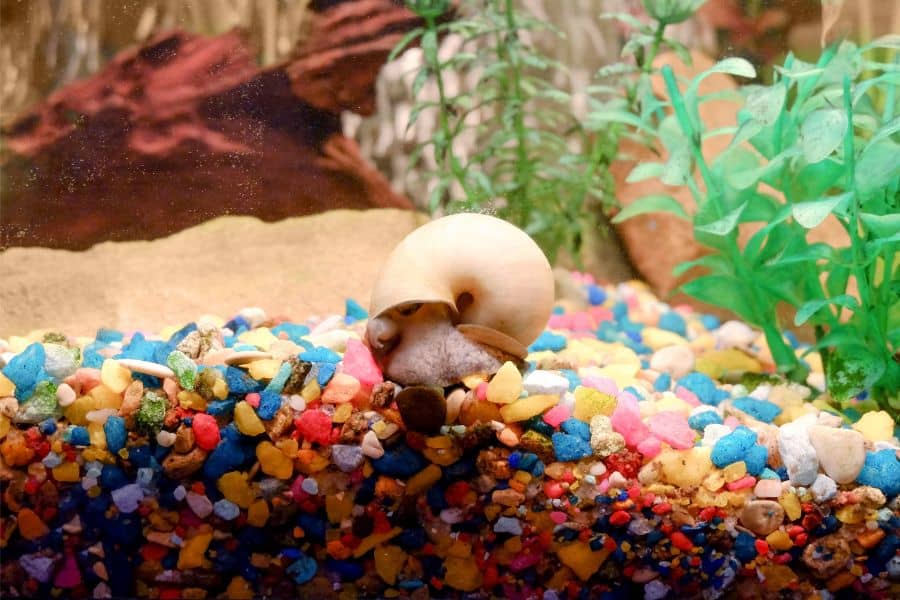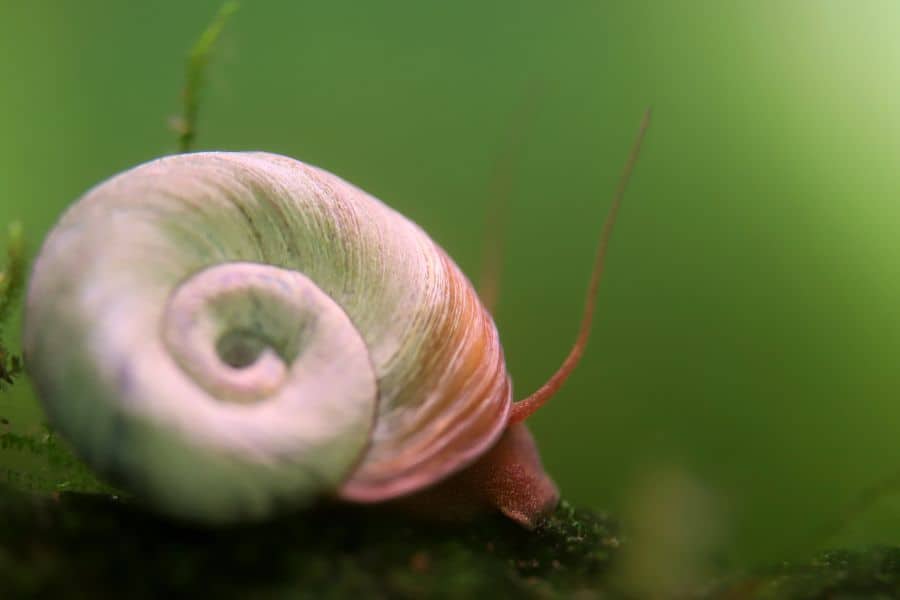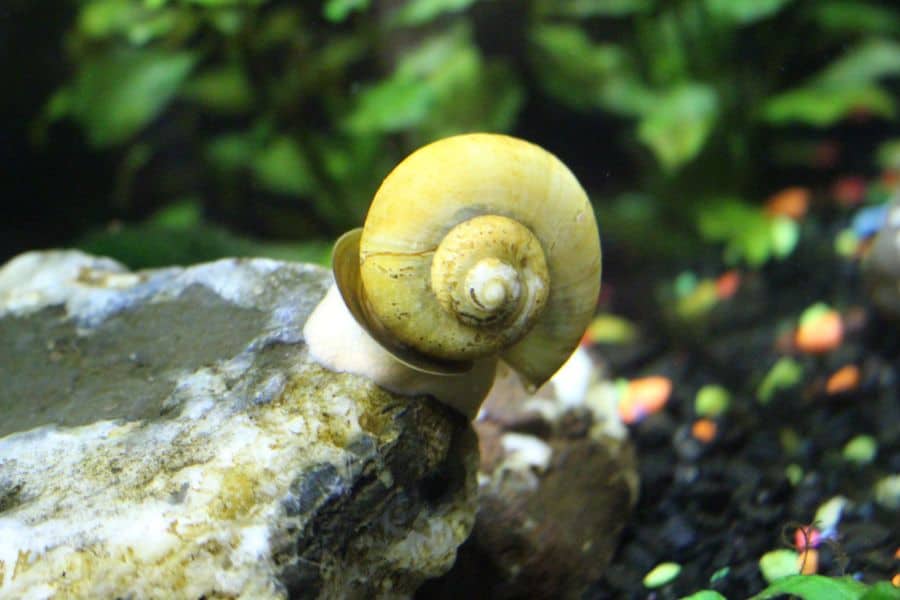If you are concerned about the diet of your aquarium snail, then you will be glad to know that, in general, most snails will thrive on algae and plant-based diets, all of which are naturally available in the aquarium and easy to provide.
However, it should be noted that some snail also requires animal protein. A good example of this is the Nassarius saltwater aquarium snail. It is a great tank cleaner that vigorously eats leftover foods and helps stir up the sandy substrate at the bottom of the tank.
In this comprehensive guide, we’ll cover everything you need to know about what to feed aquarium snails. We’ll also discuss the popular types of snails, their dietary preferences, and what they can and cannot eat.
What Do Freshwater Aquarium Snails Eat?
Aquarium snails are fascinating creatures that many fish enthusiasts love to keep. These snails are a popular addition to freshwater aquariums, serving as both an aesthetic and functional element.
Many of these snails are great scavengers that will help keep your tank clean by eating algae and uneaten foods.
However, many aquarium owners are often unsure of what to feed their snails. This may also be a bigger burden when you are juggling between their diet and the diet of other aquatic animals in the fish tank.
There are other factors to consider when feeding snails; the species, the type of snails, their purpose in the tank, the shapes & sizes, functionality in the tank, as well as their natural diet in the wild.
The factors that determine a snail’s diet include:
1. Snail Species
Most aquarium snail species can be divided into two main categories based on their dietary preferences: herbivorous and omnivorous.
Many examples of freshwater snails rely on plant matter, algae, dead matter, dead fish, and uneaten fish food.
These snails can switch between these different diets since they are also scavengers that will graze the surfaces of the tank to get food from debris, decaying plants, and fish food. Whatever food is in the tank that fits their diet, be assured they will get to it.
Examples of such snails include the Ramshorn snails and Malaysian Trumpets.
Other species, like the Nerite snails, depend more on algae matter than any other source of food. They will feed on decaying leaves and leftover fish food when it warrants but will often stick to the bottom of the tank feasting on the green algae. The Nerite species is a good place to start if you want a proficient algae eater.
Carnivorous snails are rare and unusual in most aquariums. They include the assassin snails and Nassarius saltwater snails. Both can feed on an omnivorous diet but also require animal protein to supplement their diet with meaty sources. For best results, try frozen brine shrimps, pieces of fish & seafood, or freeze-dried larvae.
All species feed every day, all day. They are constant feeders that require an abundance of food at any given time in order to thrive. Whatever food source your snails like, ensure you have a good stock of it, or they may get hungry very quickly.
2. Age & Size
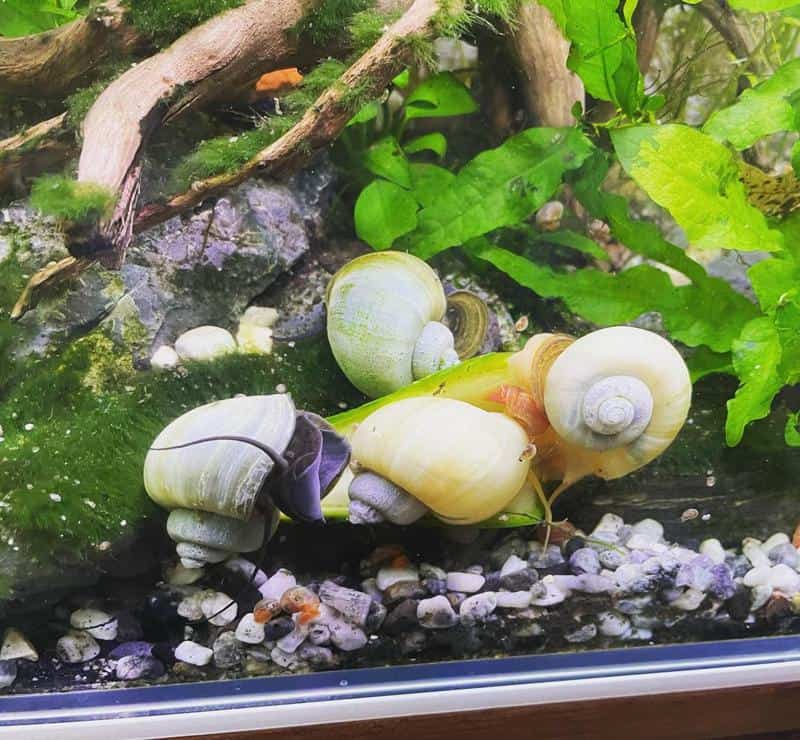
A lot of beginner aquarists wonder what baby snails eat. It can be a challenge as a beginner to narrow down a particular diet for snails, especially when they are so young and tiny that even the tiniest of vegetables feel inappropriate.
However, the good news is that snails, regardless of age and size, will eat plant-based diets with ease. This includes small cute leaves of lettuce, cabbage, zucchini, fruits, and other vegetable peelings you may have lying around.
The key thing to note when feeding baby snails is that you should aim to only use soft vegetables and fruits. A good choice is soft pawpaw leaves. This diet will ensure your baby snails get the most nourishing diet to make them grow faster and bigger while still making it easier for them to consume enough to their fill.
Baby snails are still growing; they also require more protein and calcium for their shells. They can feed on algae, detritus, and other small organisms in the tank. Additionally, they can also eat commercial snail food that is specifically formulated for their needs.
3. Habitat Food Sources
Generally, snails are omnivores. This makes for a convenient tank mate that can adapt its diet depending on available food sources. Also, as scavengers, the snails will have no problem feeding heavily on algae.
With that in mind, popular freshwater snails like the mystery snails, Bladder, and ramshorn snails are not picky with their food and will go for whatever is available in their habitat, including algae, decaying plant matter, live aquatic plants, leftovers, vegetables, and commercial snail food like Aqueon Algae Rounds & Bottom Feeder Tablets (sinking foods best for snails that dwell at the bottom).
Best Diet for Popular Freshwater Aquarium Snails
1. Nerite Snails
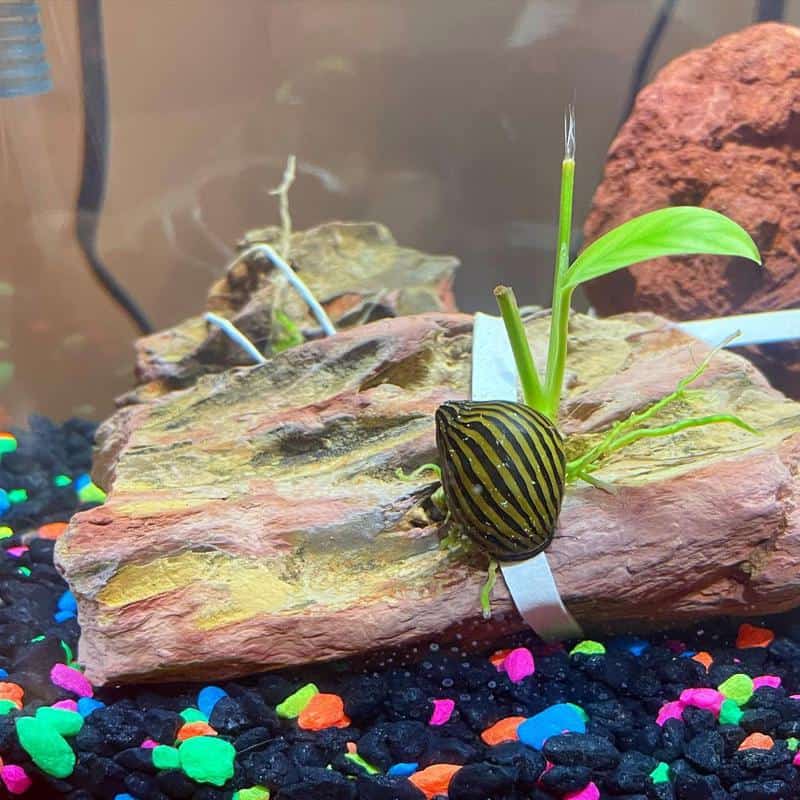
| Scientific Name | Vittina natalensis |
| Common Names | Neritina natalensis, Theodoxus natalensis, or Nerites |
| Average Size | 0.5 inches to 1.5 inches |
| Lifespan | 1 – 2 years |
| Ideal Temperature | 65 – 85 degrees Fahrenheit |
| Ideal pH Levels | 7 – 8.5 |
| Water Hardness | Freshwater: 6 – 12 dGH
Saltwater: 15 – 18 dGH |
Nerite snails are one of the most popular algae-eating snails (mostly green algae). They prefer to feed on brown algae, green algae, and diatoms.
They will eat most types of algae, including green & brown algae, diatoms, and hair algae. However, they may also eat some types of plants if they are hungry. To ensure that your nerite snails are getting enough food, you can supplement their diet with commercial snail food.
2. Ramshorn Snails
| Scientific Name | Planorbella duryi and Planorbarius corneus |
| Common Names | Ram’s horn snail |
| Average Size | Below 1 inch |
| Lifespan | 1 – 3 years |
| Ideal Temperature | 70 – 78 degrees Fahrenheit |
| Ideal pH Levels | 7 – 8 |
| Water Hardness | 7 – 15 GH
8 (5 -15) KH |
Ramshorn snails prefer eating algae, delicate plants, and uneaten food. It is because of this reason that they are a popular infestation in many aquariums.
They are omnivorous by nature and will eat algae, detritus, and uneaten fish food. They may also feed on plants if they are hungry. They are not picky eaters and will scavenge for food at the bottom of the tank.
However, it is important to note that they can breed rapidly and may become a nuisance if their population is not controlled.
3. Assassin Snails
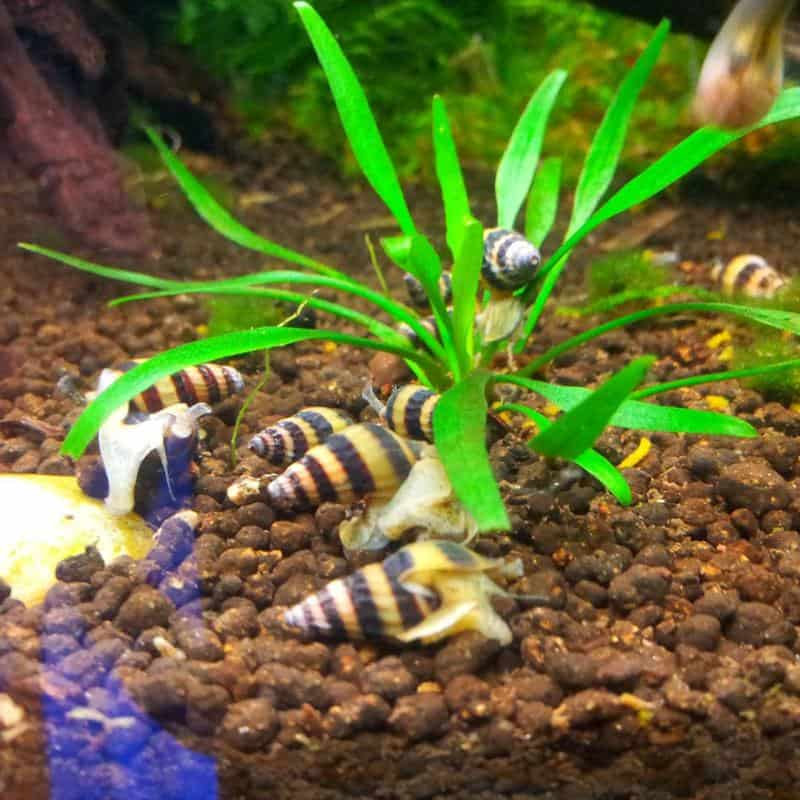
| Scientific Name | (Anentome helena or Clea helena) |
| Common Names | Bumblebee snail |
| Average Size | 0.25 inches to 1 inch |
| Lifespan | 1 – 2 years, about 3-5 years in the most ideal environment |
| Ideal Temperature | 64 – 85 degrees Fahrenheit |
| Ideal pH Levels | 7.0 – 8.0 |
| Water Hardness | 2 – 15 dKH |
Assassin snails are carnivorous by nature and can turn cannibalistic if they do not have enough meaty foods to supplement their diet.
They feed on other snails and smaller aquatic animals, including shrimp but will thrive on an omnivorous diet for some time, so long as they still have an animal protein-based diet.
They are a great addition to aquariums that have a snail infestation. However, it is important to note that they will only eat certain types of snails. They prefer smaller snails and may not be able to take on larger ones.
Additionally, they may also feed on fish eggs and small fish, and they do not eat algae.
4. Mystery Snails
| Scientific Name | Pomacea bridgesii |
| Average Size | 1 inch to 2.5 inches |
| Lifespan | 1 – 2 years |
| Ideal Temperature | 68 – 84 degrees Fahrenheit |
| Ideal pH Levels | 7.6 – 8.4 |
| Water Hardness | 12 to 18 kH
8 to 18 gH |
As long as your tank is in normal working conditions, algae will naturally grow at the bottom, which will serve as the Mystery snails’ main source of food.
You can add plants like the Java moss and hornworts in a tank since they are the few live aquatic plants that mystery snails enjoy. These plants act as supplementary foods.
Mystery Snails are scavengers who prefer dead decaying plants over live plants. These snails can sense dying material and feed on them; they are good indicators of a dying plant.
These snails will also feast on dead vegetation on most parts of the tank, from the glass surface to the filters. Small leafy vegetables like zucchini slices, lettuce, and kale are good foods to supplement its other food sources.
5. Bladder Snails
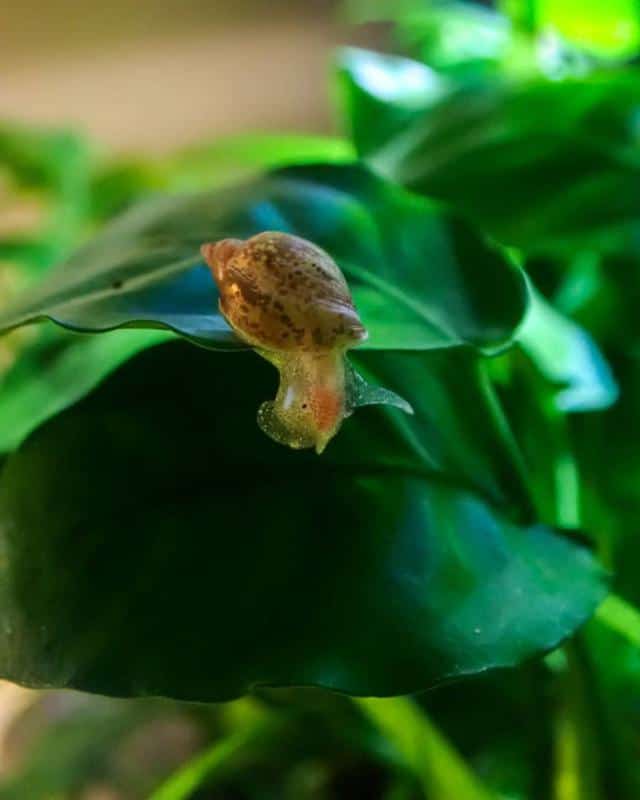
| Scientific Name | Physella acuta |
| Common Names | European physa, the acute bladder snail, or tadpole snail |
| Average Size | 0.5 inch to 0.6 inches |
| Lifespan | 1 – 2 years, about 3-5 years in the most ideal environment |
| Ideal Temperature | 68 – 84 degrees Fahrenheit |
| Ideal pH Levels | 7.0 – 8.0 |
| Water Hardness | 12 to 18 kH
8 to 18 gH |
Bladder snails are active waste and algae eaters, which makes them a great option for low-maintenance waste management. Snails can be a good solution to a tank that frequently suffers from overfeeding because they will snack on all the left, from meats to vegetables.
As omnivores, bladder snails also feed on meaty fish food and leftovers.
6. Malaysian Trumpet Snails
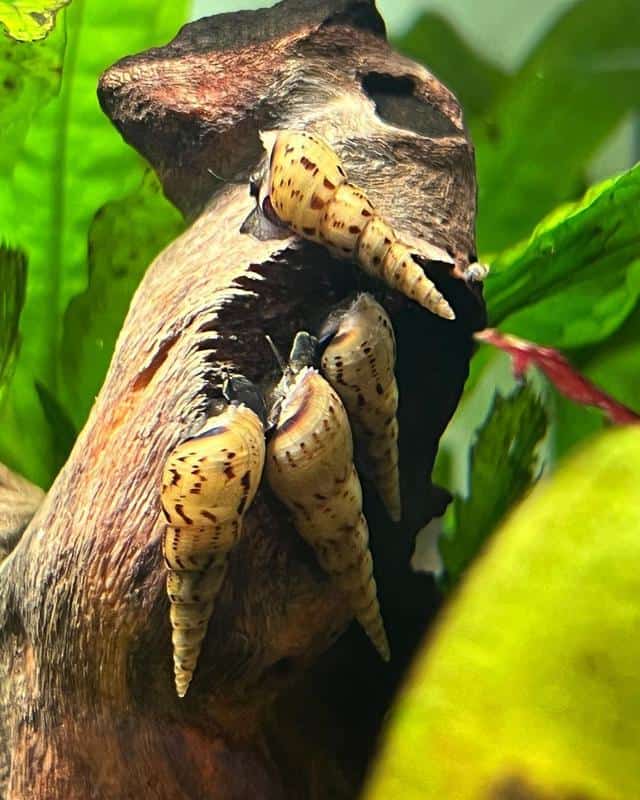
| Scientific Name | Melanoides tuberculata |
| Common Names | Malaysian live-bearing snails, trumpet snails, Malaysian burrowing snails, Malaysian sails, or trumpets |
| Average Size | 1 inch |
| Lifespan | 1 – 2 years |
| Ideal Temperature | 68 – 84 degrees Fahrenheit |
| Ideal pH Levels | 7.0 – 8.0 |
| Water Hardness | 6 – 15 kH |
Malaysian Trumpet Snails consume uneaten fish food, dead plant matter, soft algae, and other small organisms.
These snails are beneficial to aquariums because they help to keep the substrate clean by breaking down waste materials. Additionally, they do not typically harm live plants in the aquarium, so they can be a useful addition to a planted tank.
Also Read:
Frequently Asked Questions
Do Snails Eat Algae Like Brown Algae?
Many species of aquarium snails, such as Nerite snails, Ramshorn snails, and Mystery snails, are known to eat algae, including brown algae.
However, it is important to note that snails should not be relied upon as the sole means of controlling algae growth in the tank. They should be supplemented with regular maintenance and water changes to ensure a healthy and balanced ecosystem.
Do Snails Eat Fish Poop?
Snails are scavengers and will eat almost anything they can find in the tank. This particular trait has made many hobbyists believe that snails can eat fish poop, but this is not true.
Snails have a great sense of smell. They quickly know where the tastiest foods are in the tank and swiftly move towards it immediately.
The same does not happen with fish poop; snails are not drawn to fish poop; they disdain the biowaste as much as any other tank mate and won’t help feed on it regardless of the food source in the tank.
Conclusion
By now, you know that feeding snails a diet that is high in vegetables and algae will help keep them happy and healthy. These small creatures are also constant feeders that eat all day, every day. Enough food for them to eat all day is more important than a specific diet.
Whether you have herbivorous or omnivorous snails, it’s essential to provide them with a varied diet that meets their nutritional needs. Also, do not forget to add meaty foods to the few snails that require animal protein to survive.
